Medals relating to Chicago
As always, you can click or tap medals to see the reverse. Some medals might have multiple variants that differ in material, size, or other details. If multiple variants are available you can drag or slide medals sideways to display them.


This medal's obverse bears a male figure with wings affixed to his outstretched arms, four different methods of manned flight in background: a hot air balloon, a dirigible, and two early-model airplanes.
The reverse bears bird in flight. Across center, PROGRESS / IN / AVIATION / CHICAGO NUMISMATIC SOCIETY / MEDALLIC SERIES / MCMX
The second art medal issued by the Chicago Numismatic Society (the precursor to the Chicago Coin Club) was dedicated to Aviation. In the early 20th century Chicago was one of the hotbeds of aviation engineering. Thus it came as no big surprise that it was decided to pick Progress in Aviation as the theme for an art medal. Carl Schrieber won the competition for the design of this medal.
The circular medal measures 51mm in diameter and was struck in bronze by Whitehead & Hoag of Newark, New Jersey. The reported mintage in bronze is 200 pieces. The silver pieces were struck later, possibly by the U.S. Mint. No mintage is reported.
References: Malpas 186


This medal's obverse bears Chicago skyline as seen from Lake Michigan, seal of City of Chicago in upper half. Around, STATE BANK OF CHICAGO / 1879 - 1919
The reverse is inscribed with: IN COMMEMORATION OF THE / FORTIETH ANNIVERSARY / OF THE STATE BANK OF CHICAGO / DECEMBER 8TH 1919; maker's mark at bottom, W.&H.CO.NEWARK,NJ.
State Bank of Chicago was an American banking firm which conducted business under a state of Illinois charter issued on February 10, 1891. State Bank of Chicago operated from offices in the Chamber of Commerce Building located at the southeast corner of La Salle and Washington streets in Chicago, Illinois. State Bank of Chicago was a successor to the private banking partnership of Haugan & Lindgren, Bankers which had been in operation since 1879. Haugan & Lindgren had been housed at No. 57 and No. 59 La Salle Street, Chicago. That bank was founded by Norwegian born Helge Alexander Haugan and his partner John R. Lindgren. It had initially focused on the large population of Scandinavian residents within the Chicago area.
In 1929, Walter W. Head took over as president of State Bank of Chicago and guided through a merger with Foreman National Bank. All of the State Bank’s assets were transferred to the Foreman National. The merger with Foreman National eventually made the remaining institution, the Foreman-State Bank, one of the three largest banks in Chicago. During June 1931, the Foreman-State Bank was acquired by the First National Bank of Chicago.
The medal measures 76mm in diameter and was struck in bronze by the Whitehead and Hoag Company of Newark, New Jersey.
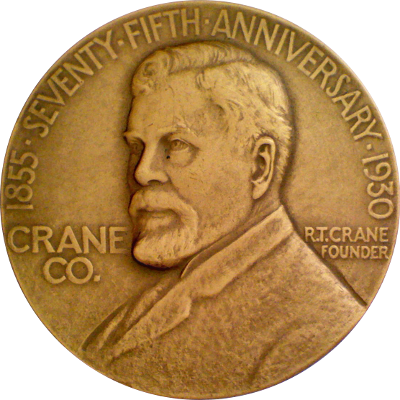

The obverse bears bust of Richard T. Crane facing left, surrounded by 1855 · SEVENTY · FIFTH · ANNIVERSARY · 1830 with CRANE / CO. in field to left and R.T.CRANE / FOUNDER to right.
The reverse bears a banner with 1930 above an large factory in the upper half, CHICAGO in the center with a small factory building below, JULY / FOURTH to left and right and 1855 below, signed J © S at the bottom edge.
This medal measures 63mm in diameter and was struck by the Medallic Art Company of New York.

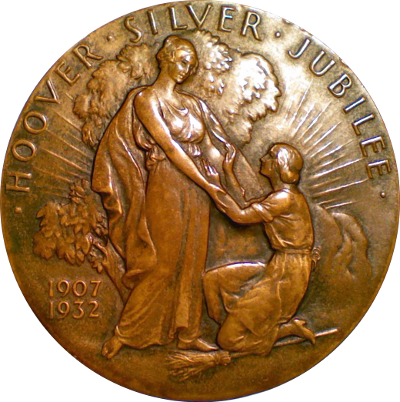
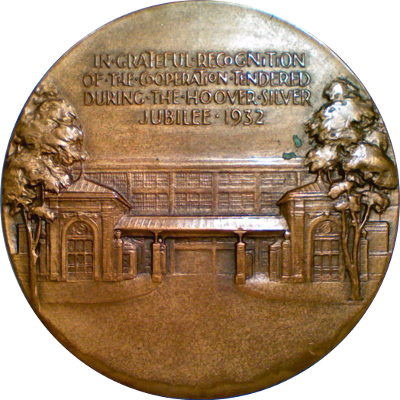
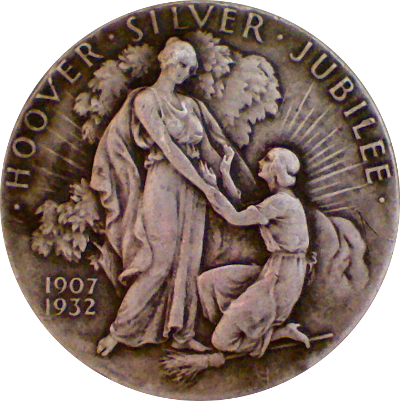
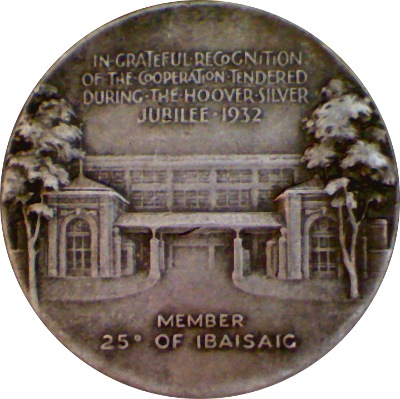
The obverse bears kneeling woman with old-fashioned broom beneath her being raised by goddess; trees and sun in background. Above, HOOVER SILVER JUBILEE; at lower left, 1907 / 1932.
The reverse bears image of Hoover's factory. Above, IN GRATEFUL RECOGNITION / OF THE COOPERATION TENDERED / DURING THE HOOVER SILVER / JUBILEE 1932; Small silver has dedication below, MEMBER / 25 (circle) OF IBAISAIC.
The token has the following maker's mark at 6:00: MEDALLIC ART CO NY SILVER
IBAISAIC stands for "It beats... as it sweeps... as it cleans," the Hoover Company's advertising slogan invented by Gerald Page-Wood, an art director of Erwin, Wasey & Company, in 1919. The slogan referred to the action of revolving brushes that vibrated the carpet to loosen trodden-in dirt and provied early Hoover vacuum cleaners a distinct advantage over competitors' models.
This medal's obverse design was picked up again one year later. Hoover exhibited at the Chicago Worlds Fair in 1933 and handed out bronze tokens to visitors of the Hoover Exhibit.
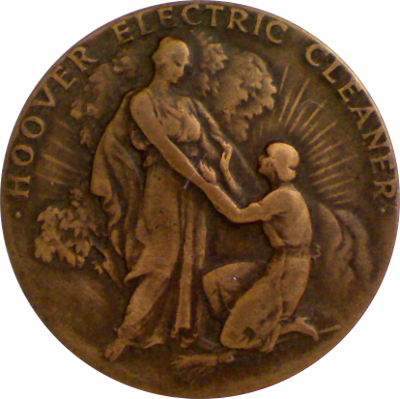
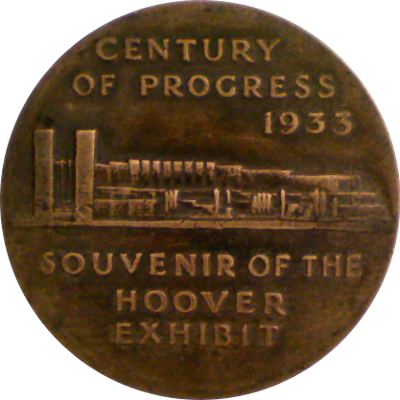
The obverse bears kneeling woman with old-fashioned broom beneath her being raised by goddess; trees and sun in background. Above, HOOVER ELECTRIC CLEANER
The reverse bears image of Chicago fair grounds. Above, CENTURY / OF PROGRESS / 1933; below, SOUVENIR OF THE / HOOVER / EXHIBIT
The Hoover Company was founded as a floor care manufacturer in North Canton, Ohio, in 1908. It so completely dominated the electric vacuum cleaner market in the first half of the 20th century that "hoovering" became synonymous with vacuum cleaning, much as "googling" became synonymous with web searching at the beginning of the 21st century.
This is such a handsome token, and also one whose imagery is so completely over the top! I would never belittle the impact that the invention of the vaccum cleaner had on a woman cleaning house in the 1930s, but I always have to smile at the woman's look of abject adoration at the prospect of being freed from toil and at the rising sun promising a brighter future.
The token measures 32mm in diameter. It was handed out to visitors of the Hoover Exhibit at the Chicago Cenury of Progress Exhibition of 1933. Its obverse is based on the Hoover Silver Jubilee token from one year earlier.


This medal's obverse bears a view of the Travel and Transport Building on the World's Fair grounds. Above, A / CENTURY / OF / PROGRESS; below, PULLMAN CIRCLE / BANQUET / OCTOBER 12 - 1933
This medal's reverse bears the P C logo of the Pullman Circle.
The Pullman Car Company was one of the big sponsors of the Chicago World's Fair. George Pullman had been long dead by 1933 but his company still had a strong local presence in Chicago. In 1880 he had bought 4,000 acres of land 14 miles south of Chicago and hired well-known architects and city planners to design a model town for his factory workers. The town was widely praised and hailed as a model city and indeed, according to mortality statistics, it was one of the most healthful places in the world.
Despite or in addition to the good intentions of its founder, it was also expected to turn a profit for the Pullman Company. This became an issue in 1894 when a depression forced layoffs and wage reductions at the Pullman factories without commensurate reductions in rents and fees in the factory town. The resulting strike spread to cover the entire nation and, after a round of intentional escalations, federal troops were brought in and 34 people died. Pullman and the railroad owners won the battle but widespread public condemnation lost them the war. In 1897 the Illinois Supreme Court ordered Pullman to divest itself of the town of Pullman. In 1898 it was annexed by the city of Chicago.
In the early 1930's, a few years before its forcible breakup, the Pullman Car Company was still a strong company. The Pullman Circle referenced on the medal was the company's Family Club that organized social and athletic events for employees.
I know neither the artist nor the mint which struck this handsome World's Fair medal. Please contact me if you have any additional information.
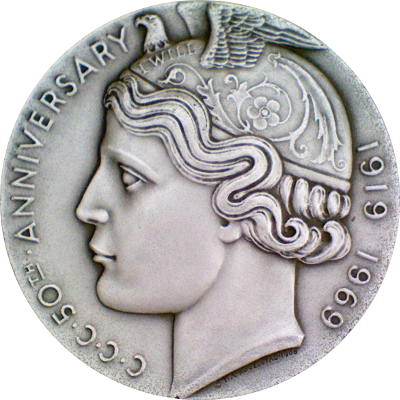
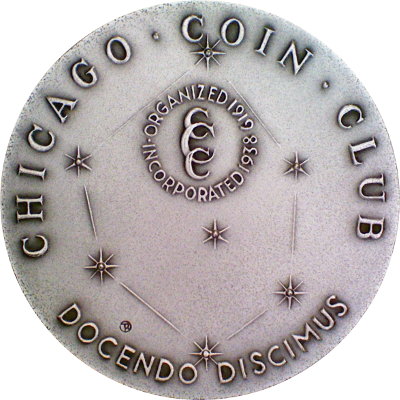
This medal's obverse bears modernized head of Arethusa, wearing winged and eagle-headed helmet with motto I WILL, facing left. Around, C · C · C · 50TH · ANNIVERSARY - 1919 1969; signed under truncation, © T · A · ROVELSTAD · 1968
The reverse bears the six Winter Hexagon stars and Betelgeuse in the middle. Around edge, CHICAGO · COIN · CLUB / DOCENDO DISCIMUS; inside stars, conjoined CCC logo surrounded by ORGANIZED 1919 · / INCORPORATED 1938; signed with (TR monogram)
The 50th anniversary of the Chicago Coin Club was celebrated January 8, 1969 with a banquet at Harding's Restaurant. The 77 in attendance had only one regret - that the bad weather kept many away. Trygve Rovelstad had been asked to create the corresponding anniversary medal and picked the head of his proposed Arethusa statue for the design. The medal's reverse was designed to be usable for future Club medals. Apparently, a quantity of nickel-silver and silver uniface medals were struck to have a cache of engravable medals on hand.
This is a very handsome medal and definitely one of the nicest Coin Club issues of modern times. Too many coin clubs issue medals with relatively boring busts of club presidents whereas this design is truly worthy of being immortalized on a medal.
The circular medal measures 57mm in diameter and was struck in bronze and silver by the Medallic Art Company of New York. The reported mintage is 182 pieces in bronze and 113 pieces in silver. The bronze medals originally cost $5 and the the silver medals $20 and were sold to members only.
References: MACo 1968-136
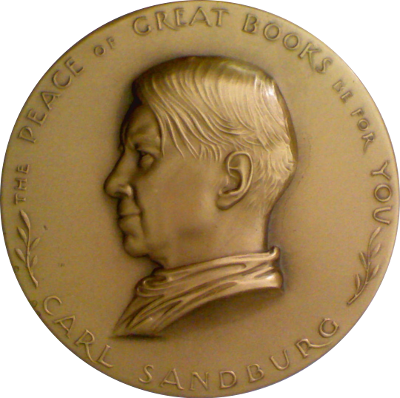
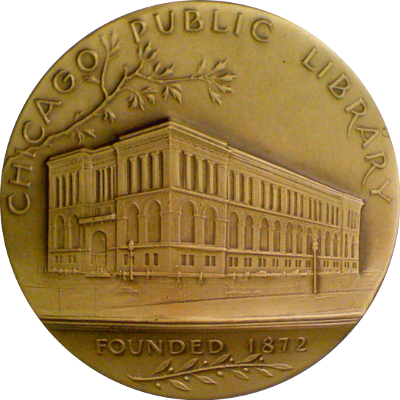
The medal's obverse shows bust of Carl Sandburg l. Around, THE PEACE OF GREAT BOOKS BE FOR YOU - CARL SANDBURG
The reverse bears view of facade of Chicago Public Library under tree branch. Above, CHICAGO PUBLIC LIBRARY; in exergue, FOUNDED 1872
Carl Sandburg (1878-1967) was an American poet, writer and editor. He won three Pulitzer prizes, two for poetry and one for his Lincoln biography. Sandburg was a supporter of the Civil Rights Movement and was the first white man to be honored by the NAACP as a "major prophet of civil rights in our time."
The medal's obverse is still used today for the Chicago Public Library's Carl Sandburg Literary Awards.
The medal measures 63mm in diameter and was struck in bronze by the Medallic Art Company of New York.


This medal's obverse bears allegorical figure representing the Spirit of Exploration at the top; in the center are two explorers surrounded by Native Americans, some of whom are carrying a canoe. Signed on base, J E FRASER
The reverse bears multi-line inscription: COMMEMORATING / THE / SEVENTY-FIFTH / ANNIVERSARY / OF THE / CHICAGO COIN CLUB / 1919 - 1994 / ✶ ✶ ✶ ✶ / "THE DISCOVERERS" / A SCULPTURE BY / JAMES EARLE FRASER / MICHIGAN AVENUE BRIDGE / CHICAGO, ILLINOIS; in rectangle below, incuse serial number 00011.
The medal is a reduced replica of a famous Chicago sculpture by James Earle Fraser. The monumental sculpture is one of a set of four that decorate the Michigan Avenue Bridge. The chewing gum tycoon William Wrigley, Jr. paid for both "The Discoverers" and "The Pioneers", this design's sibling monument. The sculpture is dedicated to Father Jaques Marquette, Robert Cavalier de LaSalle, and Henri de Tonti, who explored the Great Lakes area in the late 17th century.
This medal was issued to commemorate the 75th anniversary of the Chicago Coin Club, historically one of the most active collectors' organizations to issue medals.
The irregularly shaped plaquette measures 67mm x 89mm. It was struck in a mintage of 1 piece in gold, 36 in silver and 165 in bronze. The original subscription price was $2,165 for the piece in gold, $125 for a silver piece, and $20 for the more common bronze variant.


This medal's obverse bears allegorical figure at the top, pointing onward; below, a purposeful man walking with shouldered musket and a hatchet in one hand; next to him, a woman on horseback, holding a baby; completing the group are two more pioneers, a Native American, and an oxen. Signed on base, J E FRASER
The reverse bears multi-line inscription: COMMEMORATING / THE / EIGHIETH / ANNIVERSARY / OF THE / CHICAGO COIN CLUB / 1919 - 1999 / ✶ ✶ ✶ ✶ / "THE PIONEERS" / A SCULPTURE BY / JAMES EARLE FRASER / MICHIGAN AVENUE BRIDGE / CHICAGO, ILLINOIS; in rectangle below, incuse serial number 00011.
The medal is a reduced replica of a famous Chicago sculpture by James Earle Fraser. The monumental sculpture is one of a set of four that decorate the Michigan Avenue Bridge. The chewing gum tycoon William Wrigley, Jr. paid for both "The Pioneers" and "The Discoverers", this design's sibling monument. The sculpture was completed in 1928, eight years after the bridge.
This medal was issued to commemorate the 80th anniversary of the Chicago Coin Club, historically one of the most active collectors' organizations to issue medals.
The irregularly shaped plaquette measures 67mm x 89mm. It was struck in a mintage of 2 pieces in gold, 32 in silver and 105 in bronze. The original subscription price was $2,500 for the piece in gold, $150 for a silver piece, and $35 for the more common bronze variant ($30 if preordered). In addition to the finished medals, 11 process sets that consisted of nine bronze pieces, starting with the blank, unstruck planchet and ending with the finshed medal were sold for $250 each.